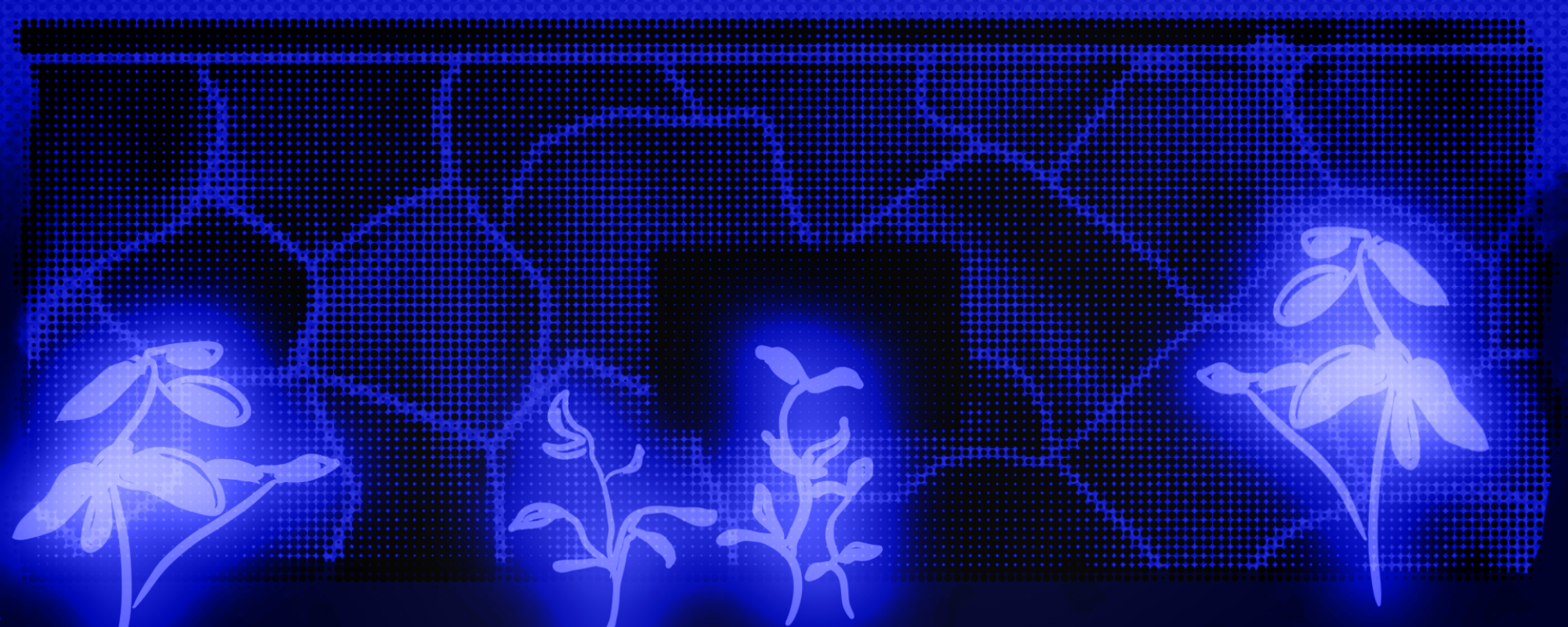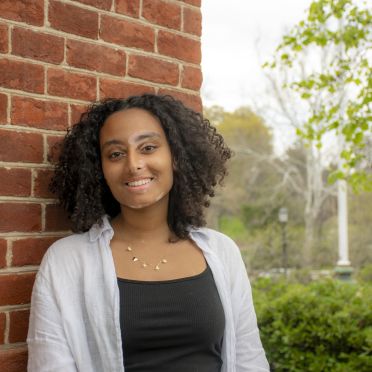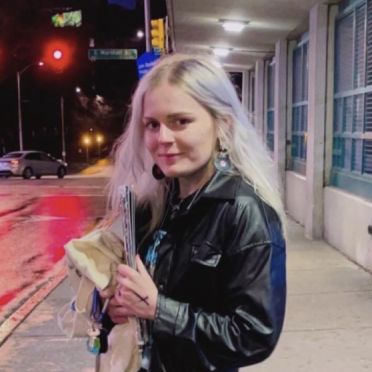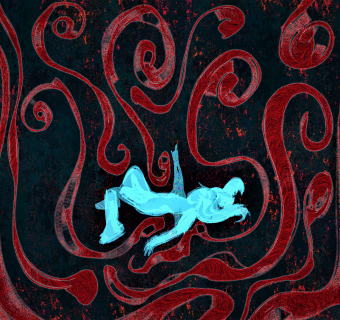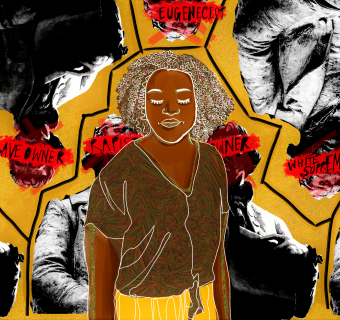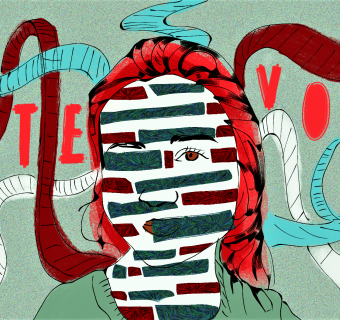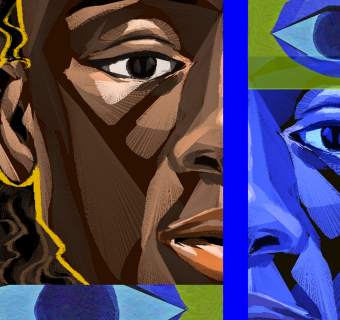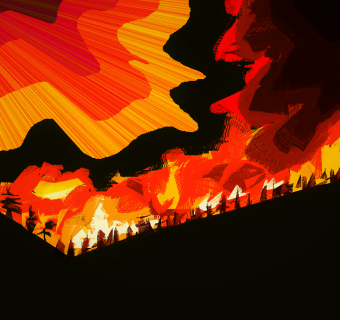The inception of HEAAL tours
In their first year, seven members of the class of 2023 — Kyndall, Amanda, Chloe, Dianna, Ephrata, Ida and Abena — took a historical tour as part of a requirement for one of their classes, the genesis of what would become the HEAAL tours for first-year students three years later.
“We were all part of the forum's curriculum, the Ideals and Injustices group to be exact,” Ephrata said. “We were required for one class period to go on a tour with Professor Nelson. It was a historical tour on grounds, specifically focusing on enslaved laborers at the University.”
The tour with Nelson illuminated how the institution of slavery was embedded, historically and structurally, into the Grounds of the University itself. “We were engaging with it physically because he would point somewhere and say here, this terrible thing happened… this was a place where people would dig up certain people's remains,” Ephrata said. “It was not just the content, but it was disturbing that we just learned this. Other students who aren't in the forum's curriculum, will never learn it. We didn't want the story of enslaved laborers to go unnoticed and unheard,” Ephrata said.
This tour ignited the seven women’s interest in ensuring that this information was accessible to their peers.
Initially, their activism started off as a question proposed to Nelson after the tour about the Gooch Dillard residence halls. During the tour, they learned that those first-year residence halls were built on top of unmarked graves of enslaved laborers who were held in bondage by the Maury family. However, they had little to no information about the cemetery except a few interpretive panels, and wanted to know more.
Their question inspired an interest in better contextualizing the history of these graves. The seven students, with the support of Nelson, decided to write a letter, get student petitions and send it to University administration to push for improved contextualization of the site. Their petition received hundreds of student signatures and was sent to University President Jim Ryan, Dean Groves, Vice President Lampkin, Chief of Staff Meghan Faulkner, Professor von Daacke, and Members of the Board of Visitors. They proposed to include a brief history of the Maury family in the description of Gooch Dillard Dormitories on the Housing and Residence Life website. They also asked that every student assigned to those dorms be presented with the history of the cemetery in their housing assignment email. However, this proposal never came to fruition.
It was this petition where the founding members first toyed with the idea of a historical tour and a debrief session specifically for first years. The original letter stated, “It is essential that the University makes its enslaved laborer tour and discussion of the history of slavery at U.Va mandatory during Welcome Week.”
After sending the letter, HEAAL started working alongside Nelson and History Prof. Kirt von Daacke, both of whom supported the group’s efforts, to create a comprehensive and transparent program that would shed more light on the University’s history with slavery.
“We turned into this body that wanted to [establish] a standardized educational program for first-years,” Kyndall said. “We felt like it was really important that it came from a centralized place [where] everybody was getting the same information. We felt like the most important thing was just to give people the access to the knowledge, and then they can go off and be hopefully responsible citizens of this land and of our nation.”
When creating the tours themselves, HEAAL worked with the University Guides Service. With U-Guides, they came up with the architecture of the tour, which was made easier by the general historical tours of the University that U-Guides was already giving. HEAAL collaborated with U-Guides, reorienting the focus to be specifically about the underrepresented narratives of enslaved laborers at the University and the creation of the Memorial to Enslaved Laborers.
“We already had the content,” said Reva Joshi, chair of U-Guides at the time, and former fourth-year College student. “It was a matter of focusing on just that early period of history and pulling more stories about enslaved laborers from our resources.” In her second year, Joshi had thought about implementing a mandatory historical tour for first-year students independently of HEAAL to cover the University's rich history more broadly. Nevertheless, she was ecstatic when HEAAL reached out to involve U-Guides in creating a historical tour aimed at first-years about enslaved laborers at the University.
After the first meeting between HEAAL and U-Guides in December 2020, it took a little less than a year to prepare the tours in order to begin offering them to first-years in the fall of 2021. The 15 tour guides who volunteered to give the new HEAAL tours had a great experience, Joshi said.
“They were excited about it,” Joshi said. “I've talked to many tour guides who said it was one of the most rewarding tours [they’ve] ever done. It's always really exciting to see first-years process U.Va., learn about it and take away their own meaning from it.”
Joshi calls the tours “one of the most special things” she’s worked on at the University and remembered the feeling of fulfillment and satisfaction she felt after witnessing one of the first tours.
“I was sitting in the Rotunda when I think a group of 30 first-years came to get a tour and it was pouring rain, and they did the entire thing in the rain,” Joshi said. “They were committed to it and they were excited about it. The tour guide told me it was the craziest tour they’d ever given, and it was so fulfilling that [the students] were engaged with it even though they were going through all this in the rain.”
Alongside HRL, HEAAL coordinated the outreach to first-year Resident Advisors and Senior Resident staff to ensure that first-year students attended these tours during their first semester at the University. Each first-year residence building was assigned a weeklong period during which residents were offered several time slots in which to attend a tour. After the tours, students participated in one of two debrief sessions to discuss the content covered in the tours. These debrief sessions were facilitated by BRIDGE and complemented the HEAAL tours, and allowed students to “digest, unpack and apply what they learned about the University’s history and present perpetuation of racism.”
BRIDGE is a student-led CIO focused on fostering dialogue designed to confront and unpack white fragility, privilege and supremacy, aiming to encourage and equip participants of all backgrounds to understand and take ownership of the intersection between students, race and the University culture. It was co-founded by four former fourth-years— Batten student Natalie Abbey, Commerce student Austin Hammond, and College students Deric Childress Jr. and Dom Bailey — in the spring of their first year.
Abbey noted in an email statement to the Cavalier Daily how rewarding it was to work with both HEAAL and Guides on the dialogues and to see their effect on first-year students.
“I enjoyed talking to and learning with first-years, many of whom showed up because they learned about the legacy of slavery at U.Va. and wanted to be a part of challenging racism in the present throughout their college years,” Abbey said.
“Education and dialogue are critical pieces of anti-racism, and to create space for learning with and from each other is powerful.”

